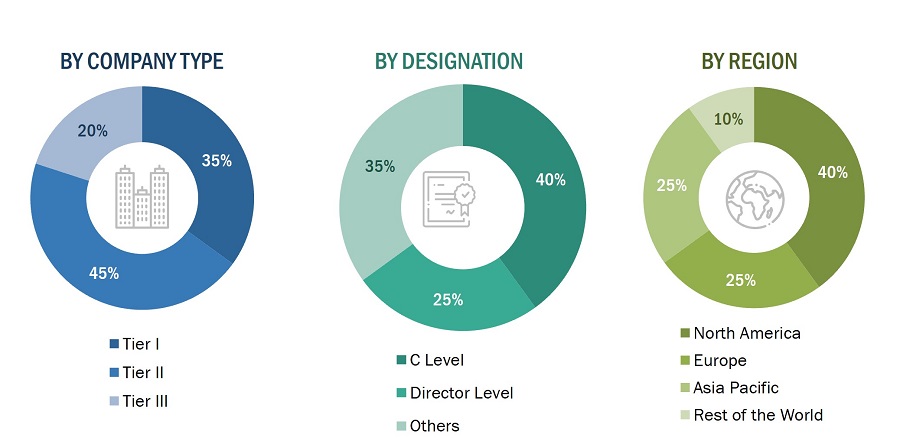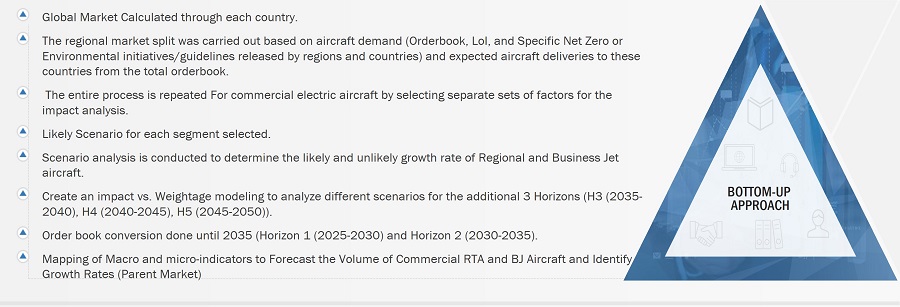The research study on the commercial electric aircraft market involved the extensive use of secondary sources, directories, and databases such as Hoovers, Bloomberg BusinessWeek, and Factiva to identify and collect information relevant to the market. Primary sources included industry experts, service providers, manufacturers, solution providers, technology developers, alliances, and organizations related to all segments of this industry's value chain. In-depth interviews with primary respondents, including key industry participants, subject matter experts, industry consultants, and C-level executives, were conducted to obtain and verify critical qualitative and quantitative information about the commercial electric aircraft market and assess the market's growth prospects.
Secondary Research
The market share of companies in the commercial electric aircraft market was determined using secondary data acquired through paid and unpaid sources and analyzing the product portfolios of major companies operating in the market. These companies were rated based on the performance and quality of their products. Primary sources further validated these data points.
Secondary sources referred to for this research study on the commercial electric aircraft market included government sources, such as International Air Transport Association (IATA), Boeing Outlook 2023, Airbus Outlook 2023, and federal and state governments of various countries; corporate filings, such as annual reports, investor presentations, and financial statements; and trade, business, and professional associations; among others. Secondary data was collected and analyzed to determine the overall size of the commercial electric aircraft market, which was further validated by primary respondents.
Primary Research
Extensive primary research was conducted after acquiring information regarding the commercial electric aircraft market scenario through secondary research. Several primary interviews were conducted with market experts from both the demand and supply sides across major countries of North America, Europe, Asia Pacific, and Rest of the World, which includes Middle East, Africa and Latin America. Primary data was collected through questionnaires, emails, and telephonic interviews.

To know about the assumptions considered for the study, download the pdf brochure
Market Size Estimation
-
Both top-down and bottom-up approaches were used to estimate and validate the size of the commercial electric aircraft market.
-
Key players were identified through secondary research, and their market ranking was determined through primary and secondary research. This included a study of annual and financial reports of the top market players and extensive interviews of leaders, including CEOs, directors, and marketing executives.
-
All percentage shares, splits, and breakdowns were determined using secondary sources and verified through primary sources. All possible parameters that affect the markets covered in this research study were accounted for, viewed in extensive detail, verified through primary research, and analyzed to obtain the final quantitative and qualitative data. This data was consolidated, enhanced with detailed inputs, analyzed by MarketsandMarkets, and presented in this report.
Commercial Electric Aircraft Market Size: Bottom-up Approach

Commercial Electric Aircraft Market Size: Top-Down Approach

Data Triangulation
After arriving at the overall size from the market size estimation process explained above, the total market was split into several segments and subsegments. The data triangulation and market breakdown procedures explained below were implemented, wherever applicable, to complete the overall market engineering process and arrive at the exact statistics for various market segments and subsegments. The data was triangulated by studying various factors and trends from both the demand and supply sides. Along with this, the market size was validated using both top-down and bottom-up approaches.
The following figure indicates the market breakdown structure and the data triangulation procedure implemented in the market engineering process to make this report on the commercial electric aircraft market.
Market Definition
A commercial electric aircraft is a fully electric aircraft which uses electric motors powered by batteries to drive its propulsion units. Technological advancements in the field of aerospace engineering have contributed to the development of electric systems, which includes all-electric propulsion systems, and electric sub-systems. The commercial electric aircraft market includes regional transport aircraft having seating capacity of above 20 seats and business jet of less than 20 seats used for short haul range of less than 200 km, mid haul range of 200 to 500 km and long-haul range of above 500 km, for scheduled and non-scheduled commercial operations that are in use or are under development phase globally.
The market is driven by the constant evolution of technology, leading to the development of advanced commercial electric aircraft that contribute to fuel efficiency, reduced maintenance costs, and enhanced mobility. Growing demand for modernized aircraft, increased air travel, and the imperative for regulatory compliance further propel the commercial electric aircraft market.
Key Stakeholders
Various stakeholders of the market are listed below:
-
Raw Material Suppliers
-
Commercial Electric Aircraft Manufacturers
-
Technology Support Providers
-
Distributors
-
System Integrators
-
Government Agencies
-
Investors and Financial Community Professionals
-
Research Organizations
Report Objectives
-
To define, describe, segment, and forecast the size of the commercial electric aircraft market based on platform, range, power, and region.
-
To forecast the size of market segments with respect to four major regions, namely North America, Europe, Asia Pacific, and the Rest of the world
-
To identify and analyze key drivers, restraints, opportunities, and challenges influencing the growth of the market
-
To strategically analyze micromarkets1 with respect to individual growth trends, prospects, and their contribution to the market
-
To analyze opportunities for stakeholders in the market by identifying key market trends
-
To analyze competitive developments such as contracts, acquisitions, expansions, agreements, joint ventures and partnerships, product developments, and research and development (R&D) activities in the market
-
To provide a detailed competitive landscape of the -market, in addition to an analysis of business and corporate strategies adopted by leading market players
Available customizations
Along with the market data, MarketsandMarkets offers customizations as per the specific needs of companies. The following customization options are available for the report:
Product Analysis
-
Product matrix, which gives a detailed comparison of the product portfolio of each company
Regional Analysis
-
Further breakdown of the market segments at the country level
Company Information
-
Detailed analysis and profiling of additional market players (up to 5)



Growth opportunities and latent adjacency in Commercial Electric Aircraft Market